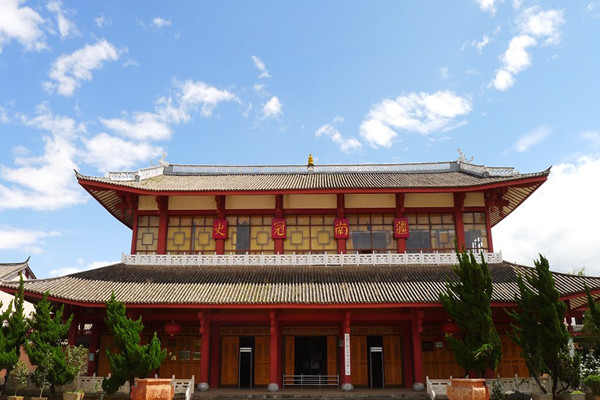Dali Bai Autonomous Prefecture Museum
Chinese Name:大理白族自治州博物馆
Englishi Name: Dali Bai Autonomous Prefecture Museum
Dali Bai Autonomous Prefecture Museum is near the Erhai Dock, located in the east of Erhai South Road in Xiaguan Town of Dali City, Yunnan Province. It was built in 1986, and has a total area of 50 mu (about 8 acres). It is really a garden Museum with strong local ethnic minority’s characteristics. It combines ancient Dali architectural styles and Bai architectural styles. The museum is also the central institution where the government of Dali Bai Autonomous Prefecture conducts cultural relic research, excavations, collecting, exhibiting and so on.
Dali Bai Autonomous Prefecture Museum has delightful surroundings. Its exhibition hall shows the clear domestic house architectural style of Bai: ‘Three rooms and one wall screening, four joints and five courtyards’. The layout of the Museum adopts symmetric forms. All of its constructions seem to be one integrated mass, reflected in the surrounding pines and cypress. Dali Bai Autonomous Prefecture Museum itself is a great architectural work of art of the Bai ethnic minority. It is indeed worth visiting when traveling in Dali.
Dali City has a history of more than 4,000 years. Nanzhao Kingdom (738-902) and Dali Kingdom (937-1253) were set up successively in Dali. Thus the museum has great cultural relics. Dali Bai Autonomous Prefecture Museum is a compilation of Dali history, through which you can appreciate the charms of the historical civilizations in Dali.
Dali Bai Autonomous Prefecture Museum is the first Autonomous Prefecture Museum in Yunnan Province. Although established only 20 years ago, it already has amassed a considerable collection. It holds more than 7,000 sub-collections including historical, ethical, revolutionary and cultural relics, fine marbles and other materials. Among these are many items found nowhere else in the world but the Dali Bai Autonomous Prefecture Museum. These include a Dali Bronze Drum, Serial Bells, etc. from the time of the Warring States (476BC-221BC); the Earthenware House and the Earthenware Horses from the Western Han (206 BC – 24 AD) to the Jin Dynasty (265-420); Buddhist Maitreya’s Pictures made of different materials, fine natural marble pictures like ‘A Peacock in his Pride’ from the Nanzhao Kingdom and the Dali Kingdom.
The Nanzhao Kingdom and Dali Kingdom historical relics and the ethnic relics of Bai are the most important exhibitions. The art of bronze and ceramic sculptures are the mainstay. Dali Autonomous Prefecture Museum is a local synthetic Museum. The Museum has twelve main exhibition halls. Eight of these exhibit year-round, including ‘Bronzes Cultural Relics Exhibition Hall’, ‘Nanzhao Kingdom and Dali Kingdom Stone Carving Arts Exhibition Hall’, ‘Nanzhao Kingdom and Dali Kingdom Painting Arts Exhibition Hall’, ‘Chinaware Exhibition Hall’, ‘Fine Marble Exhibition Hall’, ‘Nanzhao Kingdom and Dali Kingdom Cultural Relics Exhibition Hall’, ‘Bai Folk-custom Exhibition Hall’, ‘Dali Modern Revolutionary Historical Sites Relics Exhibition Hall’, etc. The exhibitions have deep cultural connotations. The first five exhibition halls fully show the foundry, construction, sculpture, and painting achievement of the Nanzhao and Dali Kingdoms. The next two show the local Dali people’s unique ancient life style and production systems, and their ancient arts and customs. The last mainly shows the revolutionary story of the patriots in Dali and historical sites where the Red Army passed by here during their Long March (Changzheng, the strategic shift of the Red Army of China in 1934–1936).
Note: The best time to visit is from March to June. In this period, Dali has the March Celebration Activities and the camellias are blossoming. The climate is also very comfortable.

 7 Days GolfingTour
7 Days GolfingTour
 8 Days Group Tour
8 Days Group Tour
 8 Days Yunnan Tour
8 Days Yunnan Tour
 7 Days Shangri La Hiking
7 Days Shangri La Hiking
 11 Days Yunnan Tour
11 Days Yunnan Tour
 6 Days Yuanyang Terraces
6 Days Yuanyang Terraces
 11 Days Yunnan Tour
11 Days Yunnan Tour
 8 Days South Yunnan
8 Days South Yunnan
 7 Days Tea Tour
7 Days Tea Tour
 8 Days Muslim Tour
8 Days Muslim Tour
 12 Days Self-Driving
12 Days Self-Driving
 4 Days Haba Climbing
4 Days Haba Climbing
 Tiger Leaping Gorge
Tiger Leaping Gorge
 Stone Forest
Stone Forest
 Yunnan-Tibet
Yunnan-Tibet
 Hani Rice Terraces
Hani Rice Terraces
 Kunming
Kunming
 Lijiang
Lijiang
 Shangri-la
Shangri-la
 Dali
Dali
 XishuangBanna
XishuangBanna
 Honghe
Honghe
 Kunming
Kunming
 Lijiang
Lijiang
 Shangri-la
Shangri-la
 Yuanyang Rice Terraces
Yuanyang Rice Terraces
 Nujiang
Nujiang
 XishuangBanna
XishuangBanna
 Spring City Golf
Spring City Golf
 Snow Mountain Golf
Snow Mountain Golf
 Stone Mountain Golf
Stone Mountain Golf














